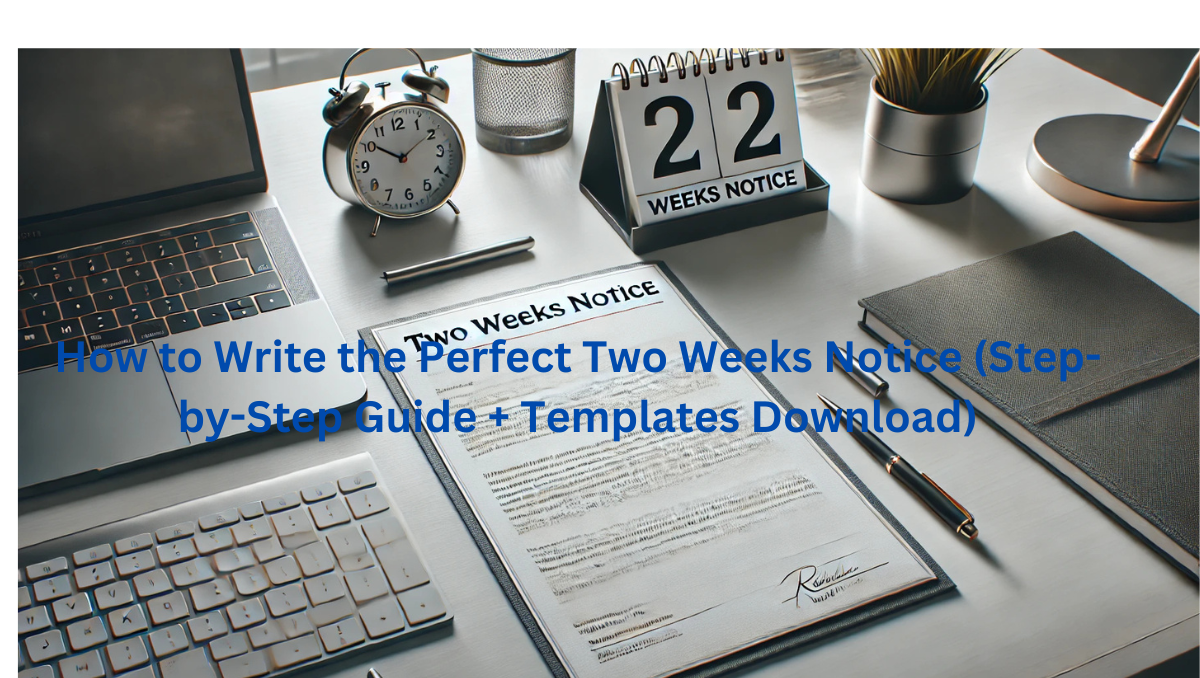Deciding to leave a job is a big step, and how you do it matters. Writing a professional two weeks notice letter can help you exit gracefully and maintain positive relationships. In this guide, you’ll learn everything you need to know to write the perfect two weeks notice letter, handle emotional and legal challenges, and ensure a smooth transition. Plus, we’ll provide customizable templates to make the process even easier.
Quick Answer: What Should Be in a Two Weeks Notice Letter?
A two-weeks notice letter is a simple, formal way to let your employer know you’ll be leaving. Here are the basic elements it should include:
- Date of resignation – State clearly when your last working day will be.
- Address the letter to your supervisor – Use a professional tone and their formal title.
- Provide a brief reason for leaving (optional) – This can be kept vague (e.g., personal reasons or new opportunity).
- Offer to assist during the transition – Show goodwill by offering help to train your replacement or finish key tasks.
- End with a professional closing – Thank your employer and sign off respectfully.
Download our Two Weeks Notice Letter Template to get started right away!
Step-by-Step Guide to Write a Two Weeks Notice Letter
Now that you know the essentials, let’s walk through how to write your letter step-by-step.
Step 1: Choose the Correct Format
Your two weeks notice should be formal but not complicated. Use professional language, but keep it short and straightforward. You can choose to write a printed letter or send it via email, depending on your company’s communication style.
Example:
Subject: Resignation – [Your Name]
Dear [Supervisor’s Name],
Step 2: Write a Clear Statement of Resignation
Begin with a polite and direct statement about your intention to resign. This makes it immediately clear why you’re writing.
Example:
“I am writing to formally notify you of my resignation from [Company Name], effective two weeks from today. My last working day will be [date].”
Step 3: Mention Your Final Working Day
Give your exact last day of work, so there is no confusion. Ensure it aligns with your notice period and any employment agreement you have.
Step 4: Briefly Offer Assistance
Offer to help during the transition period. Whether you’re training your replacement or wrapping up unfinished projects, this goodwill gesture will leave a positive impression.
Example:
“I am happy to assist in the transition process in any way I can, including training a replacement or completing any outstanding tasks.”
Step 5: Express Gratitude and Close Professionally
End your letter on a high note. Thank your employer for the opportunity and the experiences you’ve gained during your time with the company.
Example:
“I am grateful for the opportunities I’ve had at [Company Name], and I appreciate the support and guidance over the years. I wish the company continued success moving forward.”
Handling Emotional and Professional Dynamics
Leaving a job can be an emotional process, and navigating this professionally is crucial for preserving relationships and your reputation. Here’s how to handle common challenges during the notice period:
Managing Difficult Conversations
When you give notice, your supervisor might ask why you’re leaving. Stay calm and professional in your responses, avoiding negativity or blame. Keep your reasons brief and focused on personal growth or new opportunities.
How to Deal with Negative Reactions
Not everyone will react positively to your resignation. If your boss or colleagues respond with frustration, remain calm and professional. It’s important not to let emotions escalate during this time.
Maintaining Professionalism
Even though you’re leaving, it’s important to keep performing your job well during your final two weeks. Show your commitment to wrapping up your responsibilities, which will leave a lasting, positive impression.
Do You Have to Give Two Weeks Notice?
While it’s standard practice in many industries to give two weeks notice, there are some legal aspects to consider:
Is Two Weeks Notice Mandatory by Law?
In the U.S., two weeks notice isn’t typically required by law, but it’s a professional courtesy. In some states, however, there may be specific legal requirements or contractual obligations that require notice before leaving.
Employee Rights During Notice
During the notice period, you are still entitled to your salary and benefits. Additionally, if you have unused vacation or sick days, be sure to check if you’ll be compensated for them according to your company’s policy.
Employer Obligations
In some cases, an employer may decide to terminate you immediately after you give notice. Be prepared for this possibility, especially if you work in a sensitive position.
What Happens After You Give Two Weeks Notice?
Here’s what you can expect after submitting your notice:
Staying Productive
Use your final two weeks to leave a strong impression. Finish any outstanding tasks, document important information for your team, and help your coworkers transition smoothly.
Handling Counteroffers
Your employer may make a counteroffer to convince you to stay. While it may be tempting, carefully weigh the pros and cons before accepting. If you decide to decline, do so professionally and with appreciation.
Final Impressions
Your last days are an opportunity to leave on good terms. Be punctual, reliable, and helpful until your final day, which will help ensure positive references in the future.
Alternatives to Traditional Two Weeks Notice
The traditional two weeks notice may not always apply, especially if you’re a freelancer, contractor, or remote worker. Here are some alternatives to consider:
For Freelancers and Contractors
In freelance or contract roles, you might not be bound to give two weeks notice. Instead, communicate a reasonable timeline for ending your work, ensuring there’s enough time to complete any outstanding projects.
Shorter Notice Periods
In some cases, a shorter notice period might be acceptable. For example, if you’re in a temporary or part-time role, a one-week notice may suffice, provided it aligns with your employer’s expectations.
Global Practices: Is Two Weeks Notice the Norm Worldwide?
While two weeks notice is common in the U.S., it’s not the standard everywhere. Here’s how it compares globally:
- United Kingdom: In the UK, employees are typically required to give one month’s notice.
- Canada: Similar to the U.S., two weeks is standard, but some provinces may require more for long-term employees.
- Japan: It’s customary to give at least one month’s notice, and in some cases, more time is expected.
FAQs on Two Weeks Notice
Here are some common questions people have when writing their two weeks notice:
Can I resign without giving two weeks notice?
Yes, but it’s not recommended unless there’s an urgent reason. Not giving notice can harm your professional reputation.
What if my boss asks me to leave immediately?
If your employer asks you to leave immediately, you may be entitled to pay for the notice period you offered. Check your employment contract.
Should I mention my future plans in the notice letter?
It’s not necessary to mention where you’re going unless you feel comfortable sharing. Focus on leaving the current position professionally.
Conclusion: Final Thoughts and Next Steps
Writing a professional two weeks notice is crucial for maintaining good relationships and leaving on a positive note. Keep it simple, straightforward, and respectful. Use one of the templates provided below to get started on your own.
Download Two Weeks Notice Templates
Feel free to share this article or explore our other resources on managing career transitions and professional growth.
Templates for Two Weeks Notice
Here are a few extra templates for different situations:
General Two Weeks Notice Template
Dear [Supervisor’s Name],
I am writing to inform you of my decision to resign from my position at [Company Name], effective two weeks from today. My last working day will be [date].
I have enjoyed my time here and appreciate the opportunities the company has provided. I am happy to assist in the transition during my remaining time to ensure a smooth handover of my responsibilities.
Thank you again for your guidance and support. I wish the company continued success.
Sincerely,
[Your Name]
Two Weeks Notice Template for a New Job
Dear [Supervisor’s Name],
Please accept this letter as my formal resignation from [Company Name], effective two weeks from today. My last working day will be [date].
I have accepted an offer with another company and am excited about this new opportunity. I am grateful for the growth and learning I’ve experienced at [Company Name] and will do my best to ensure a smooth transition.
Thank you for your support, and I wish everyone at [Company Name] the best.
Sincerely,
[Your Name]
Two Weeks Notice Template for Personal Reasons
Dear [Supervisor’s Name],
I am writing to notify you of my resignation from [Company Name], effective in two weeks. My last working day will be [date].
I have decided to step away due to personal reasons. I appreciate the time I’ve spent here and the relationships I’ve built. I will be happy to assist in the transition during my notice period.
Thank you for your understanding and support.
Sincerely,
[Your Name]
Additional Resources You May Find Helpful:
- U.S. Public School Grading Scales – Learn how public school grading systems work and compare them to other evaluation methods.
- Pros and Cons of Standardized Testing and Best Alternatives – Explore different perspectives on standardized testing, a topic that may intersect with performance reviews in various settings.
- Thank You Note to Teacher Templates Guide – If you’re leaving a job and want to show gratitude, check out this guide on how to write thoughtful thank-you notes.
- Homeschool Grading Systems: Customization Tools and State-Specific Requirements – Discover non-traditional grading methods and how they can be customized to suit different needs, which may inspire alternative evaluation strategies.
- Jack of All Trades, Master of None: Why Versatility is Your Secret Weapon – Embrace career versatility and learn why being adaptable can be a valuable asset during career transitions.

Nawab is an experienced educator with a decade of teaching across preschool to K-12 levels. Holding both a graduate degree and a diploma in elementary education, he is passionate about fostering learning environments that inspire young minds. In addition to his teaching career, Nawab has been actively blogging and writing content for the past four years, sharing insights and resources for educators and parents alike.

